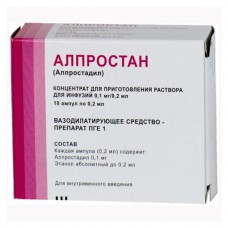Expiration date: 05/2026
Composition and form of issue:
1 ampoule with 0, 2 ml concentrate for infusions (absolute alcohol) contains alprostadil 0, 1 mg in a box of 10 ampoules.
Pharmacokinetics:
Metabolized in the lungs to 60-90% (single administration) by enzyme oxidation to form three biologically active metabolites: 15-keto-PGE1, 15-keto?13, 14-dihydro - PGE1 and 13, 14-dihydro-PGE1 (PGE0). Citometria have lower compared to alprostadil biological effect of the metabolite 13, 14-dihydro-PGE1 (PGE0) PGE1 has a comparable effect, but it works longer. T1 / 2 PGE1 is 10 s, and PGE0 is 1 min (alpha phase) and 30 min (beta phase). The main metabolites excreted in the urine and 88% feces 12%.
Description of pharmacological action:
Improves microcirculation and peripheral blood circulation, dilates arteries, arterioles and relaxes the sphincters of precapillaries improves the rheological properties of blood, increases the plasticity of red blood cells has an effect on hemocoagulation, reducing adhesion and platelet aggregation. Has fibrinolytic effect. It has an antiatherogenic effect, slowing the activation of neutrophils, excessive proliferation of cells of the vascular wall. Increases collateral blood flow. In the systemic and pulmonary circulation acts vasodilatation. It helps to increase blood flow in the cavernous bodies.
Reduces OPSS, blood PRESSURE, reflexively increases heart rate, which leads to an increase in cardiac output. Stimulates smooth muscles of the intestine, bladder and uterus suppresses the secretion of gastric juice.
Indications:
Chronic obliterating diseases of arteries of the extremities stage III-IV (Fontaine classification), accompanied by pain at rest or trophic changes: occlusive disease with severe intermittent claudication (if not shown surgical intervention), atherosclerosis of arteries of extremities of diabetic angiopathy, Buerger's disease, Raynaud's syndrome with trophic disorders vasculitis in systemic sclerosis impaired peripheral circulation because of the impact of extra-marginal vibration. Congenital ductus-dependent heart defects in newborns (for temporary maintenance of the arterial duct before reconstructive cardiac surgery).
Contraindications:
Hypersensitivity, acute and subacute myocardial infarction, severe form of angina (including unstable), heart failure in the stage of decompensation, arrhythmia, bronchoobstructive syndrome of severe severity with signs of respiratory failure, swelling or infiltrative changes in the lungs, severe liver function disorders, conditions characterized by the risk of bleeding (stomach and duodenal ulcer, severe damage to the vessels of the brain, proliferative retinopathy with a tendency to bleeding, extensive injuries) simultaneous appointment of vasodilators and anticoagulants, pregnancy, breast-feeding under the age of 18 (except neonatal period) and over 75 years. In neonatology: inhibition of the function of respiration, respiratory distress syndrome, a condition of spontaneous Stoiko-patent ductus arteriosus.
Use during pregnancy and breast-feeding:
Contraindicated in pregnancy. At the time of treatment should stop breastfeeding.
Side effect:
From the nervous system and sensory organs: headache, dizziness, fatigue, drowsiness, hypertension of the neck muscles, increased irritability.
From the cardiovascular system and blood (hematopoiesis, hemostasis): hypotension, tachycardia, angina attack, AV block, leukocytosis, leukopenia, anemia, thrombocytopenia, bleeding, hypercapnia.
Respiratory system: bradypnea or tachypnea.
From the digestive tract: feeling of discomfort in the epigastric region, nausea, vomiting, diarrhea, transient increase in liver transaminases.
Other: feeling of malaise, increased sweating may be swelling of the limbs, in the vein that is being infused hyperthermia, hypothermia, allergic reactions, reversible hyperostosis of the long bones (with prolonged — more than 4 weeks — treatment) increase in titer C-reactive protein, increased level of potassium in the blood, hyperbilirubinemia, hematuria, shock, loss of renal function, anuria, hypoglycemia, tachyphylaxis.
When side effects of the drug dose should be reduced.
Drug interaction:
- It enhances the action of anticoagulants, antihypertensive agents, antiplatelets and vasodilators.
- Pharmaceutically incompatible with other solutions (except physiological, 5 or 10% glucose solutions).
Dosage and administration:
In chronic obliterating diseases of the arteries of the lower extremities in adults: IV, drip, at least 2 h, 50-200 mg (100-500 ml of physiological or 5% glucose solution) 1 time a day, with more severe conditions — 50-100 mg 2 times a day. Recommended dilution: 1 ampoule of the drug (0, 2 ml) is diluted in 9, 8 ml of a 5% glucose solution and a concentration of 100 µg in 10 ml of the solution is diluted in 100-500 ml of an infusion solution (isotonic sodium chloride solution or 5% glucose solution). The course of treatment-14 days, with a good effect, treatment continues for another 7-14 days, the total course-no more than 4 weeks. If there is no effect during the first 2 weeks of treatment should be discontinued. With congenital ductus-dependent heart defects in newborns: I / V (through large veins or through the umbilical artery directly into the mouth of the arterial duct), drip. The initial infusion rate is 0, 01-0, 05 mcg/kg/min to achieve a therapeutic effect a dose reduce to minimum support — 0, 01-0, 02 µg/kg/min If necessary, the dose may be increased up to 0, 1 mcg/kg/min.
Overdose:
Symptoms: reduced blood PRESSURE, redness of the skin, weakness.
Treatment: cessation of infusion in the oppression of the respiratory center in newborns, ventilator is necessary.
Precautionary measures:
At/in the introduction may develop phlebitis (proximal to the injection site). This is usually not a reason to stop the treatment: signs of inflammation disappear after a few hours after the infusion or change the site of administration, specific treatment in such cases is not required. Catheterization of the Central vein can reduce the frequency of manifestations of this side effect. The number of adverse reactions increases depending on the concentration and speed of the infusion. Increase in infusion should be limited in patients with severe heart failure (risk of pulmonary edema and cardiac arrest). Caution should be exercised in patients with hypertension in elderly patients with insulin-dependent diabetes (especially with extensive vascular damage), in the appointment of newborns in the case of bradypnea, hypotension, tachycardia and hyperthermia.
In the treatment it is necessary to control hemodynamic parameters, CSCS, biochemical parameters and parameters of the blood coagulation system. A prerequisite for the use of newborns is the availability of ventilator. The drug should be used under close medical supervision.
Patients with coronary heart disease, renal insufficiency (serum creatinine more than 1, 5 mg / l) should be monitored in the hospital during treatment and for 1 day after discontinuation of treatment. To avoid symptoms of hyperhydration, the volume of injected fluid should not exceed 50-100 ml per day. It is necessary to monitor the dynamic state of the patient (blood PRESSURE, heart rate), if necessary — the control of body weight, fluid balance, measurement of Central venous pressure or echocardiography.
In patients on hemodialysis treatment with the drug should be carried out in the postdialysis period.
In patients with chronic obliterating diseases of the lower extremity arteries, the use of the drug is part of a comprehensive treatment, and the clinical effect may occur after the end of the course of treatment.
Special instruction:
The solution is recommended to use ex tempore. The prepared solution can be stored no more than 24 hours at a temperature of 2-8°C.
Storage conditions:
The prepared solution - no more than 24 hours.


